- Home
- About
- Map
- Trips
- Bringing Boat West
- Migration West
- Solo Motorcycle Ride
- Final Family XC Trip
- Colorado Rockies
- Graduates' XC Trip
- Yosemite & Nevada
- Colorado & Utah
- Best of Utah
- Southern Loop
- Pacific Northwest
- Northern Loop
- Los Angeles to NYC
- East Coast Trips
- 1 Week in Quebec
- Southeast Coast
- NH Backpacking
- Martha's Vineyard
- Canadian Maritimes
- Ocracoke Island
- Edisto Island
- First Landing '02
- Hunting Island '02
- Stowe in Winter
- Hunting Island '01
- Lake Placid
- Chesapeake
- Provincetown
- Hunting Island '00
- Acadia in Winter
- Boston Suburbs
- Niagara Falls
- First Landing '99
- Cape Hatteras
- West Coast Trips
- Utah Off-Roading
- Maui
- Mojave 4WD Course
- Colorado River Rafting
- Bishop & Death Valley
- Kauai
- Yosemite Fall
- Utah Off-Road
- Lost Coast
- Yosemite Valley
- Arizona and New Mexico
- Pescadero & Capitola
- Bishop & Death Valley
- San Diego, Anza Borrego, Joshua Tree
- Carmel
- Death Valley in Fall
- Yosemite in the Fall
- Pacific Northwest
- Utah Off-Roading
- Southern CA Deserts
- Yosemite & Covid
- Lake Powell Covid
- Eastern Sierra & Covid
- Bishop & Death Valley
- Central & SE Oregon
- Mojave Road
- Eastern Sierra
- Trinity Alps
- Tuolumne Meadows
- Lake Powell Boating
- Eastern Sierra
- Yosemite Winter
- Hawaii
- 4WD Eastern Sierra
- 4WD Death Valley +
- Southern CA Deserts
- Christmas in Tahoe
- Yosemite & Pinnacles
- Totality
- Yosemite & Sierra
- Yosemite Christmas
- Yosemite, San Diego
- Yosemite & North CA
- Seattle to Sierra
- Southwest Deserts
- Yosemite & Sierra
- Pacific Northwest
- Yosemite & South CA
- Pacific Northwest
- Northern California
- Southern Alaska
- Vancouver Island
- International Trips
- Index
- Tips
- Books
- Photos/Videos
- Search
- Contact
Carlsbad Caverns
Wednesday, July 31, 2002 - 5:45am by Lolo270 miles and 5.5 hours from our last stop - 1 night stay
Travelogue
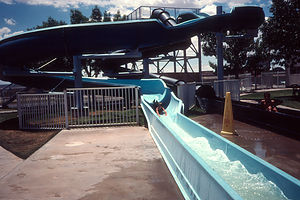 Water Slide We were on a roll now and truly felt that we were on vacation and ready for new experiences. Our next stop after a 5 hour drive was Carlsbad Caverns. As we usually like to do when we get to a new place, we checked into a campground so we didn't have to worry later about where we were going to spend the night. We chose White's City RV Park because it was the closest one to Carlsbad Caverns. Although the campground itself wasn't very scenic, it did have its advantages--a pool and a small water park.
Water Slide We were on a roll now and truly felt that we were on vacation and ready for new experiences. Our next stop after a 5 hour drive was Carlsbad Caverns. As we usually like to do when we get to a new place, we checked into a campground so we didn't have to worry later about where we were going to spend the night. We chose White's City RV Park because it was the closest one to Carlsbad Caverns. Although the campground itself wasn't very scenic, it did have its advantages--a pool and a small water park.
Although our first choice of activities is usually enjoying natural beauty and wonders, the kids (and me) every once in a while need an amusement park fix. Herb was appalled at our decision to spend a few hours at the water park instead of getting to the caves, but he was overruled. The afternoon was hot, and the water slides were refreshing and exhilarating. All potential crankiness and whining was washed away and the family mood was much improved and ready for the next adventure.
 Dad and Kids in CaveWe headed over to the National Park to check out our options for exploring the caves. Unanimously, we decided on the self-guided tour of the Big Room, the largest and most famous of the caves, with a ceiling 25 stories high and a floor the size of 14 football fields. I think the kids briefly considered taking the elevator down into the Big Room, but then wisely came to their senses. Instead we followed the original explorer's route through the Natural Entrance of the cave, a steep 1-mile descent which winds 750 feet down into the Big Room--a much better choice.
Dad and Kids in CaveWe headed over to the National Park to check out our options for exploring the caves. Unanimously, we decided on the self-guided tour of the Big Room, the largest and most famous of the caves, with a ceiling 25 stories high and a floor the size of 14 football fields. I think the kids briefly considered taking the elevator down into the Big Room, but then wisely came to their senses. Instead we followed the original explorer's route through the Natural Entrance of the cave, a steep 1-mile descent which winds 750 feet down into the Big Room--a much better choice.
As we descended the sharp switchbacks towards the Natural Entrance, we could feel the rush of cold air coming from the cave. We mistakenly thought the black birds swirling around the cave's entrance were bats, but then realized that the bats were still sleeping and these were just birds. Besides the rush of cold air, we immediately got a waft of the pungent smell of bat guano. It was eerie to think that somewhere above our heads, thousands of bats were sleeping and most likely manufacturing more guano.
Finally, after about an hour, we entered the Big Room, which was absolutely breathtaking. We spent the next hour wandering through the enormous chamber admiring the spectacular formations. As spectacular as the Big Room is, Andrew said he preferred Mammoth Cave because it was more natural and undeveloped. The Big Room had restrooms, an elevator, and even a cafeteria. You didn't get that same feeling of exploration as you did at Mammoth Cave. I, however, really felt that the formations at Carlsbad Cavern were more spectacular.
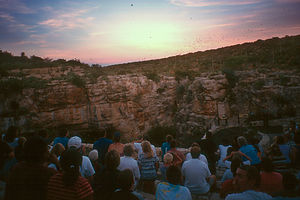 Female BatsAfter dinner in the RV, we headed back to the Bat Amphitheater to wait for the evening flight of bats from the cave's Natural Entrance. Crowds gradually filled the large stone amphitheater built around the Natural Entrance while a ranger gave a short talk on bats. He told us what time they had appeared the previous evening so we waited anxiously as that time approached. Almost to the minute, a few bats appeared and began circling the entrance to the cave. Gradually, more and more streamed out of the cave and did their circling routine before heading towards the river to feast on insects. The whole mass exodus of a quarter million Mexican free-tail bats took about 20 minutes. It was absolutely mesmerizing to watch.
Female BatsAfter dinner in the RV, we headed back to the Bat Amphitheater to wait for the evening flight of bats from the cave's Natural Entrance. Crowds gradually filled the large stone amphitheater built around the Natural Entrance while a ranger gave a short talk on bats. He told us what time they had appeared the previous evening so we waited anxiously as that time approached. Almost to the minute, a few bats appeared and began circling the entrance to the cave. Gradually, more and more streamed out of the cave and did their circling routine before heading towards the river to feast on insects. The whole mass exodus of a quarter million Mexican free-tail bats took about 20 minutes. It was absolutely mesmerizing to watch.
Description
Carlsbad Caverns National Park, in southern New Mexico, has one of the largest and most spectacular cave systems in the world. The park contains some 80 known caves that wind through the limestone of the Guadalupe Mountains.
 Cave entranceNative Americans had known about the caves for hundreds of years, but it wasn't discovered by white settlers until the 1880s. They discovered the caves because of the millions of bats that flew out of them each evening at sunset.
Cave entranceNative Americans had known about the caves for hundreds of years, but it wasn't discovered by white settlers until the 1880s. They discovered the caves because of the millions of bats that flew out of them each evening at sunset.
Jim White, a local cowboy and guano miner, began exploring the main cave in the early 1900s. As word spread, he began taking tourists through the caves. Carlsbad Caverns became a national monument in 1923 and a national park in 1930.
If you only have time to do one thing at Carlsbad Caverns, take the Natural Entrance into the cave, and hike the 750-foot descent into the Big Room. This is the largest and most famous of the caves, with a ceiling 25 stories high and a floor the size of 14 football fields. It is also the most accessible of the caves in that for those not physically able to hike from the Natural Entrance, there is an elevator that will take you directly into the Big Room from the visitor center. The fee for the self-guided Big Room tour was $6 for adults and $3 for children. Allow about 1 1/2 hours for the tour. The tour of the Big Room is a self-guided tour.
There are also several choices of ranger-guided tours through the various cave systems. There is a fee for each of these, and advanced reservations are recommended.
In addition to the cave tours, there is a ranger program offered each evening around 7:30 pm at the Bat Flight Amphitheater at the Natural Entrance. Every sunset from early spring through October, a quarter of a million Mexican free-tailed bats fly out of the Natural Entrance of the cave to begin their nightly hunt for insects.
Lake Colorado City State Park
Tuesday, July 30, 2002 - 12:00pm by Lolo550 miles and 10 hours from our last stop - 1 night stay
Travelogue
It was a long day of driving to get here, but for the first time this trip we got that exciting feeling of being somewhere very different from home. This was desert country with beautiful flowering cactus and little lizards scampering about.
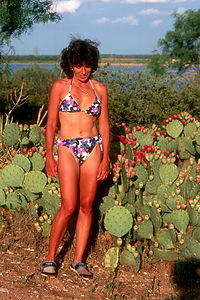 Lolo before Cactus ButtIt was early evening when we arrived, but still hot enough for an evening swim. We followed a path through the cactus down to the lake. Along the way, we encountered large groups of what looked to be fire ants, which we carefully avoided. It was a little hard getting into and out of the lake from the rocks at the edge, but the kids were much amused by my graceful entry.
Lolo before Cactus ButtIt was early evening when we arrived, but still hot enough for an evening swim. We followed a path through the cactus down to the lake. Along the way, we encountered large groups of what looked to be fire ants, which we carefully avoided. It was a little hard getting into and out of the lake from the rocks at the edge, but the kids were much amused by my graceful entry.
After dinner, we strolled down to the fishing pavilion with the boys' rods. The lake is supposed to be especially good for catfish and large mouth bass, but we didn't have much luck. Tom even tried his expert fisherman form with a hint of butt-crack showing. Still no luck.
That evening and the next morning, we took some photos in the low light. We usually like to document our trips by taking a picture of the RV in a setting that we have enjoyed. We got a good one here. One word of caution. Do not squat down to take a picture when you are near cactus. I spent the next 3 hours picking tiny cactus barbs out of my shorts.
Description
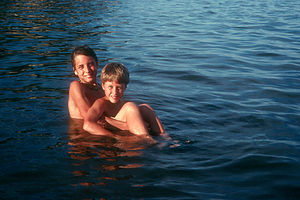 Brotherly love in Lake ColoradoLake Colorado City, one of Texas's 120 state parks, is a 500-acre park located on the southwestern corner of a 1600-acre reservoir. This reservoir, which provides water to power the largest power plant in western Texas, is also a great recreation spot for fishing, boating, and swimming. The park has three campgrounds.
Brotherly love in Lake ColoradoLake Colorado City, one of Texas's 120 state parks, is a 500-acre park located on the southwestern corner of a 1600-acre reservoir. This reservoir, which provides water to power the largest power plant in western Texas, is also a great recreation spot for fishing, boating, and swimming. The park has three campgrounds.
Monroe's Shiloh Campground
Monday, July 29, 2002 - 8:30am by Lolo80 miles and 1.5 hours from our last stop - 1 night stay
Travelogue
After crossing the Mississippi River, we continued west on I20 to Monroe, Louisiana, where we chose to spend the night at the Shiloh Campground. Upon checking in, we were handed a flier warning us of Encephalitis and West Nile Virus from mosquitoes. This was a great start. Immediately, Tommy declared that he wasn't going to step out of the RV.
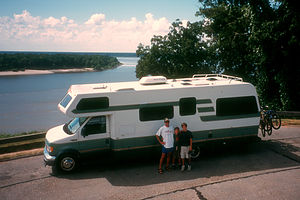 RV poised to cross the mighty Mississippi RiverWe managed to coax the kids out of the RV and we swam in a pretty nice campground pool, complete with slide. We also spent some time relaxing in the adjacent hot tub. Afterwards, the kids did do a little fishing in the lake, but unfortunately the only thing biting was the mosquitoes. So we called it an early evening and retired to the RV to watch a movie. We briefly left the safety of the RV again to do our ceremony of the placing of Louisiana on our U.S. map.
RV poised to cross the mighty Mississippi RiverWe managed to coax the kids out of the RV and we swam in a pretty nice campground pool, complete with slide. We also spent some time relaxing in the adjacent hot tub. Afterwards, the kids did do a little fishing in the lake, but unfortunately the only thing biting was the mosquitoes. So we called it an early evening and retired to the RV to watch a movie. We briefly left the safety of the RV again to do our ceremony of the placing of Louisiana on our U.S. map.
We were anxious to leave the mosquitoes and humidity of Louisiana behind the next day and head to the drier climate of Texas. I'm afraid we really didn't do Louisiana justice.
Description
The Monroe's Shiloh Campground was just a stopover on our way across Louisiana on I-20. The campground has a pool, hot tub, and small lake for fishing.
Vicksburg National Military Park
Monday, July 29, 2002 - 7:30am by Lolo280 miles and 6 hours from our last stop
Travelogue
We left the Trace in Jackson, Mississippi, and began our trek west on I20. Before crossing the Mississippi River into Louisiana, we made a brief stop at Vicksburg National Military Park. After our customary stop in the Visitor Center and the bagging of yet another collector hat pin, we went outside to watch the cannon demonstration. The soldiers loading the cannon joked that they needed a target and glanced over at Tommy who was wearing a Yankee baseball cap. Apparently, we were the only northerners in the group and we were on enemy territory. It was strange to think of it that way.
After the cannon demonstration, we drove the 16-mile auto drive through the Civil War cemetery and memorials. It was thought provoking to look at the endless lines of white gravestones and to think of how many American lives were wasted during that war.
Description
Vicksburg, which sits high on a bluff overlooking the Mississippi River, was the site of one of the most decisive battles in the Civil War. Its surrender on July 4, 1863, divided the South, and gave the North control of the Mississippi River. In 1899, Congress established Vicksburg National Military Park to commemorate its significance in the American Civil War.
The Military Park includes a 16-mile auto tour road, Vicksburg National Cemetery, 1,325 historic monuments and markers, 20 miles of reconstructed trenches and earthworks, an antebellum home, 144 cannon, and the restored Union gunboat-USS Cairo.
Wal-Mart - Belle Vernon
Friday, July 26, 2002 - 2:00pm by Lolo366 miles and 6 hours from our last stop - 1 night stay
Travelogue
There is always a great feeling of excitement and anticipation as we head out on a road trip, unsure of what the next few weeks will bring. This year was no different. We set out in the mid-afternoon to try to get some miles under our belt before nightfall. Our first planned destination was Mammoth Cave National Park in Kentucky. Since 14 hours is too much to do in one day, we drove about 6 hours the first day and stopped around 9:00 in a Wal-Mart Super Center in Belle Vernon, PA.
On just pure driving days, we often select a Wal-Mart to spend the night at rather than pulling in late into a commercial campground. All we need to do is sleep, and once you pull the shades in the RV down, you can imagine that you're anywhere, so a Wal-Mart is just as good a place as anywhere else. However, we only select Wal-Mart's when we feel we are in a safe area. We spent one rather restless night in a Wal-Mart parking lot outside Richmond, Virginia, where we had to listen to drag racing in the parking lot all night.
Description
Many Wal-Mart Supercenters allow RVs to park in their parking lots over night since they are open 24 hours.
Home
Sunday, August 5, 2001 - 9:00am by Lolo435 miles and 8 hours from our last stop - 1 night stay
Travelogue
We'd covered a lot of ground over the last 3 1/2 weeks -- probably too much ground--and learned a lot--sometimes the hard way. Too many miles with too few multi-day stops is a sure recipe for trip fatigue. Still, the trip was great and we'd gotten to visit some truly spectacular places. However, next time we'll slow down and stop to sniff the roses.
Description
Our home in Upper Saddle River, a suburb of New York City.
Streetsboro - Mar-Lynn Campground
Saturday, August 4, 2001 - 12:00pm by Lolo565 miles and 11 hours from our last stop - 1 night stay
Travelogue
Although this looked like a very nice campground, after 10 hours of driving, we didn't have the time or energy to enjoy it very much. The kids, however, did take a quick dip in the small lake in the campground..
Description
250-site campground in Streetsboro, Ohio, near such attractions as Six Flags, the Cuyahoga Valley National Forest, and the Rock n' Roll Hall of Fame. Facilities include a game room, spring-fed lake, fishing and swimming, propane, and laundry. Home-made fudge and hand-dipped ice cream are featured treats!
Devils Lake State Park
Friday, August 3, 2001 - 4:00am by Lolo144 miles and 2.5 hours from our last stop - 1 night stay
Travelogue
Too bad we hit Devil's Lake State Park on a Friday when the campgrounds were full because it would have been a great place to spend the night. The lake was very pretty--crystal clear water with 500-foot cliffs surrounding it and more than 30 miles of hiking trails to enjoy.
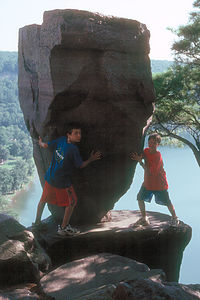 Boys holding up Balance RockThe park looked great, and after having driven more than 1,700 miles in the last 3 days, we really needed a day to just relax. So we grabbed our beach chairs and towels and settled down on the grassy beach at the north end of the lake. The sandy beach that is normally there was completely under water as a result of some recent heavy rains. The beach was a little more crowded than we like, but the water was great and it was good to just stay in one spot for a few hours.
Boys holding up Balance RockThe park looked great, and after having driven more than 1,700 miles in the last 3 days, we really needed a day to just relax. So we grabbed our beach chairs and towels and settled down on the grassy beach at the north end of the lake. The sandy beach that is normally there was completely under water as a result of some recent heavy rains. The beach was a little more crowded than we like, but the water was great and it was good to just stay in one spot for a few hours.
After lunch, we set off on a hike along the West Bluff Trail, which went along the rocky bluffs and cliffs on the western shore of the lake. About 2 miles into the hike, we arrived at the sandy beach on the opposite end of the lake and took a dip before continuing our circumnavigation of the lake on the East Bluff Trail. Along the bluffs on the eastern shore, we came upon Balance Rock, a mammoth 12-foot high, arrowhead-shaped rock, teetering precariously on top of a flat rock. We took the obligatory photo of the boys pretending they were holding up the rock, which actually moved a bit when they leaned on it. Then back to the north beach, another quick dip, and we were on our way to find a place to stay for the night.
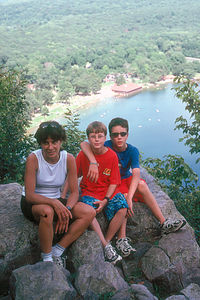 Lolo and boys on East Bluff Trail overlookWe called Baraboo Hills Campground and found that they had a few sites open. The boys were pretty excited because the Campground Guide listed all kinds of great recreational opportunities, like mini-golf, rental carts, etc. We got there at 7:55, just in time to watch the campground staff closing up all the recreational equipment. Great. Undaunted, we headed to the heated pool which was open until 10:00. I've never seen a more crowded swimming pool in my life--people standing in the water shoulder to shoulder. In the midst of this mass of humanity, some guys were actually attempting a game of football. The kids found this very amusing and spent their time lying on their backs on the bottom of the pool with their face masks on watching the chaos going on above them.
Lolo and boys on East Bluff Trail overlookWe called Baraboo Hills Campground and found that they had a few sites open. The boys were pretty excited because the Campground Guide listed all kinds of great recreational opportunities, like mini-golf, rental carts, etc. We got there at 7:55, just in time to watch the campground staff closing up all the recreational equipment. Great. Undaunted, we headed to the heated pool which was open until 10:00. I've never seen a more crowded swimming pool in my life--people standing in the water shoulder to shoulder. In the midst of this mass of humanity, some guys were actually attempting a game of football. The kids found this very amusing and spent their time lying on their backs on the bottom of the pool with their face masks on watching the chaos going on above them.
A good time was had by all. We were relaxed and refreshed and ready for the final push home.
Description
Devil's Lake State Park is in Baraboo, Wisconsin, 14 miles south of the Wisconsin Dells. It is located along the Ice Age Trail, which traces the glacial ridges of Wisconsin for hundreds of miles.
Back in the late 1800s, train tracks ran along the shores of the lake bringing guests to the elegant hotels lining the shore. The hotel era ended in 1904 and few traces of it remain. Now people come to enjoy the natural beauty--the 360-acre, crystal clear Devil's Lake and the beautiful 500-foot cliffs that surround it.
Today the park is popular for many outdoor activities, such as swimming, boating, scuba diving, fishing, hiking, mountain biking, and even rock climbing. There are two large, sandy beaches, one at either end of the lake. There are more than 29 miles of hiking trails, including the West Bluff Trail and East Bluff Trail, which go along the rocky bluffs and cliffs around the entire lake. There are many interesting rock formations to explore, including Balanced Rock and the Devil's Doorway.
The park is extremely popular, so the 406 campsites in the park fill up quickly during the summer.
St. Paul - KOA
Thursday, August 2, 2001 - 12:30pm by Lolo605 miles and 11 hours from our last stop - 1 night stay
Travelogue
After leaving Manitoba, we headed south and back into the States. Nothing fun today--just one of those long days of driving that come at the end of a cross country trip. 11 hours was just too much today. Tomorrow we need to find some fun.
Description
71-site campground with a heated pool right off I94
Saskatchewan
Tuesday, July 31, 2001 - 11:45am by Lolo561 miles and 11 hours from our last stop - 1 night stay
Travelogue
We left the Rocky Mountains in Jasper and headed east across the prairies of central Canada on our long trek home, a little sad that the last of our planned highlights was over.
Not having much information on Saskatchewan, Herb and I stopped in a Visitor Center to see what recreational opportunities the province had to offer--biking, hiking, rafting, etc. To our surprise, the Visitor Center was manned by two old woman who had to be pushing ninety. Undaunted, I approached them and asked my planned question about recreational opportunities. They stared blankly at me. At this point, Herb started to crack up and had to walk away and bury himself in the pamphlet rack. "Sign the book!" one of the ladies responded quite emphatically. I glanced over to where she was pointing and saw that she wanted me to sign the guest log. I complied and asked my question once again to which the other one responded, "Where are you from?" "New Jersey," I replied. "Oh, Saskatchewan," she nodded and smiled. At that point, Herb could not control himself any longer and quickly left the Visitor Center. After a few more questions and random responses, I smiled politely at them and got out of there as quick as I could. Herb was still laughing when I got to the RV.
Still not having the slightest idea as to what to do in Saskatchewan, we drove about 10 hours to Saskatoon and stopped at a pretty campground overlooking a park and some ball fields. It was a lovely evening, so we sat in our beach chairs on the bluff watching the baseball games going on below. This was the first time the entire trip that I got homesick. Both our boys love baseball and if we hadn't been traveling, this is what they would have been doing. Most of our stops prior to this one had been tourist destinations, but what we were seeing now were people living their normal daily lives. Traveling is great, but I like my normal life too. I guess it's time to go home.
Description
Saskatchewan, located in central Canada just east of Alberta, is one of the least visited provinces in Canada, having neither mountains or seacoast to draw visitors. Rather than a tourist destination, Saskatchewan, which is part of the great prairies, serves as the breadbasket of Canada producing 60% of its wheat.
The Trans-Canada Highway (Highway 1) and Highway 16 pass through the southern part of the province, which is the more populated part. The entire province, which is 5 times the size of New York State has only 1 million people living in it. The less populated northern part of the province is mostly forest and lakes and is considered a hunting and fishing paradise with other 30,000 square miles of lakes.
Prince Albert National Park, 150 miles north of Saskatoon, is the province's only national park. In the forests and lakes of this pristine million-acre wilderness area, there is canoeing, swimming, hiking, and great wildlife viewing. There are 31 provincial parks in Saskatchewan as well.
